Creating a Point of Contact Between Socioeconomics and Culture: A New Art×Business Endeavor Interrogates the World From Bakurocho.
Creating a Point of Contact Between Socioeconomics and Culture: A New Art×Business Endeavor Interrogates the World From Bakurocho.

With multiple distinctive galleries opening over recent years, the eastern Nihonbashi area is becoming known as a city of the arts. And when “Art Technologies Co., Ltd.” opened their new gallery space “BAF STUDIO TOKYO” last year, it was in Bakuro-yokoyama, Nihonbashi. The company’s mission is to increase the number of connections between the arts and culture, and the economy, and they offer services including office coordination and development of EC services using AR technology, in addition to art sales. For this issue, we spoke with Art Technologies Representative Directory and President Mr. Atsuhiko Suematsu – who states they aim to increase the relative value of art – and curator Mr. Kotaro Hosono - who has made a name for himself in the underground art world – about the relationship between art and business, the role of art in the coronavirus era, and more.
The important thing is to show the art we believe in.
-First, please tell us how you to came to know each other, as the company’s co-founders.
Mr. Atsuhiko Suematsu (“Suematsu”): My parents had always run a gallery, and I worked there after graduating from college. Then I went out on my own at 25, and launched a gallery in Nagoya in 2015. But the building we rented in was demolished three years later, so from there I moved to Tokyo and founded Art Technologies.

President Atsuhiko Suematsu of Art Technologies.
-Did you flow into a job in art naturally, given your parents’ jobs?
Suematsu: I guess so. I was always drawn to the work of painting since I was a child. It was just that, at the time, society tended to look down on it a bit. Like, “art galleries are shady businesses.” I had very complex feelings about it when people said that sort of thing. Starting the current company was also partly a challenge, taking on the work of teaching society broadly about the value of art.
Mr. Kotaro Hosono (“Hosono”): Part of what brought me here was starting an alternative space called ANAGRA in the Hanzomon area back in 2013, when I was 27. We would invite musicians and performance artists as well as holding art exhibitions; we aimed to be a place where everyone could enjoy doing what they wanted generally, beyond just functioning as a gallery. I organized exhibitions once every week or two as the owner and curator at the time, which is pretty fast-paced.

Mr. Kotaro Hosono, the curator.
Hosono: After that, I stepped down as owner three years after the opening, and someone who had been a patron of ANAGRA at the time took over. After taking off again from there, Mr. Suematsu spoke to me about helping out, since he was launching Art Technologies. When we first spoke about it, I was surprised by all his specialized art knowledge, but I sensed a synergy with the love of art that underlies his knowledge.
Suematsu: We both ran galleries for three years at our last jobs, but while Mr. Hosono is young and showcased unknown artists, I had exclusively exhibited preeminent names like Gozo Yoshimasu, Tenmei Kano, and Shimon Yotsuya. While they might seem like opposites, both are hard to sell (laughter).
Hosono: Mr. Suematsu, you’re friends with a lot of artists in their 80s (laughter).
-So you both handle fairly niche artwork, then?
Suematsu: Yes, we do. More than actually doing business in art with an established reputation, we handle good “pieces to buy now” that we anticipate will rise in value in the future. There’s a philosophy that holds we should handle items with established reputations if we just want to make money, and we’re deliberately choosing another approach.
Hosono: If we can’t definitively say that “it’s genuinely good” and be culpable for that, we can’t even talk about selling it to someone. I think that showing pieces we believe in is simple, but critical.
A unique communication technique that jumps between analog and digital.
-Could you tell us more about your business at Art Technologies?
Suematsu: Our foremost, basic philosophy is our desire to see art become a communication tool in our daily lives. We want it to spark conversations, open the way to new interpersonal relationships, and show people paths for intellectual curiosity. To achieve that, the company offers a wide variety of approaches to create opportunities for people to obtain artwork, and to associate with the arts. Specifically, we have art sales and rental services leveraging e-commerce. We run a gallery and hold events to discover new talent from the present art scene. We produce murals and coordinate offices to make vibrant, creative business spaces. Finally, we consult and advise individuals on art collections and sales. Those are our four primary fields of business.
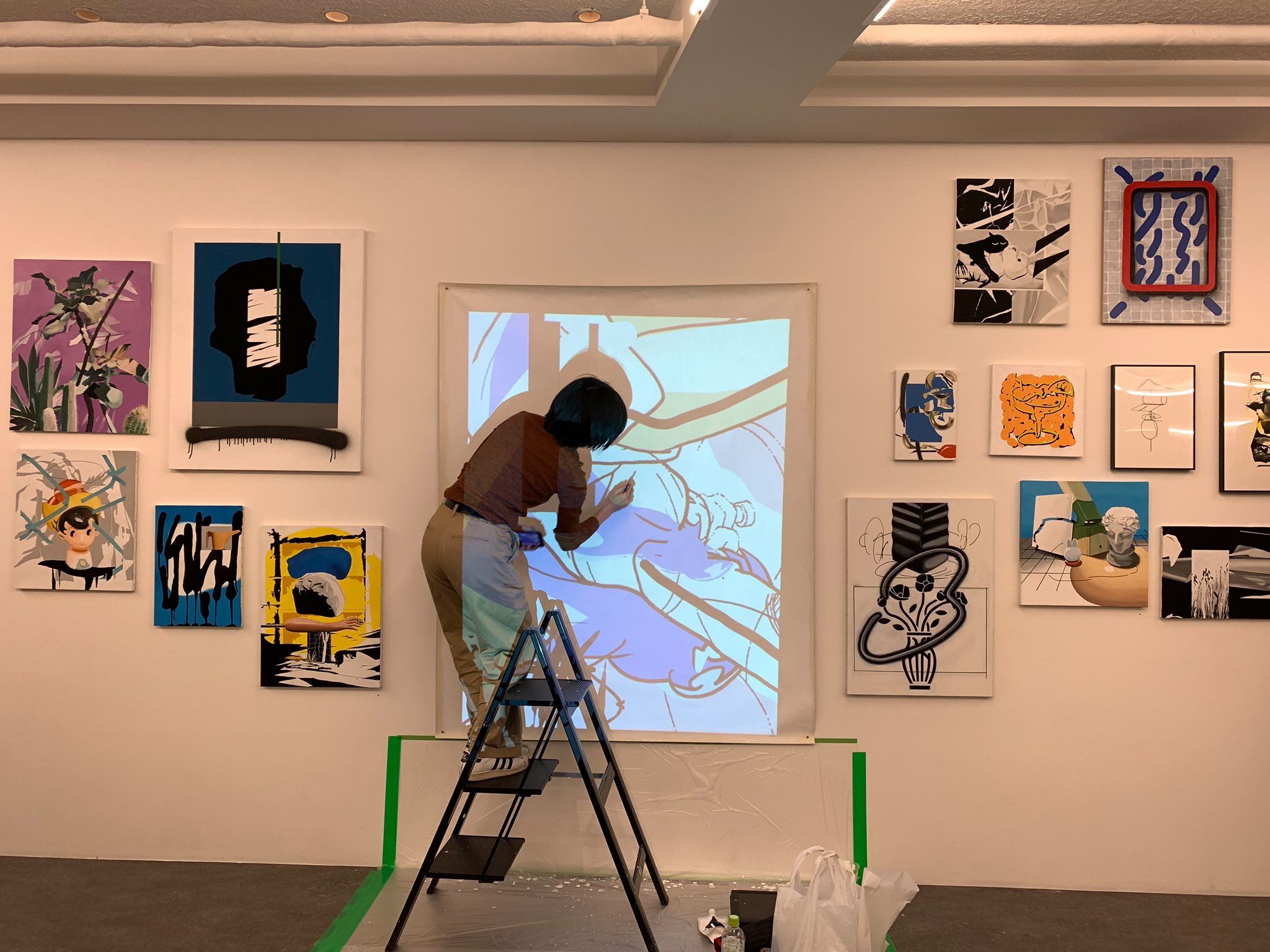
Art Technologies also discovers noteworthy artists and supports them as they face the challenge of the world stage (Image provided by: Art Technologies)
-Do you incorporate technology into each field of business, as the company name implies?
Suematsu: Yes, we do. But even in regard to technologies, our image is less of changing art itself with the latest technology, and more of using digital tools as an aid to get artwork to customers more smoothly and precisely. For example, we just launched the website “ART TECHNOLOGIES ONLINE” in June, and we’re focused on video streaming via YouTube and Vimeo in order to showcase scenes of the artists at work and interviews, rather than just art sales.
Hosono: Incorporating digital elements lets us share a focus on the appeal of the artist as a person, to a wide audience, in a way that viewing artwork in person can’t convey. Knowing how a piece was made changes how we view it, and archiving information this way also functions as an online catalog or art magazine, which lets us broadcast it both within Japan and internationally.
Hosono: If we had gone with a specialty painting purchasing and sales website, only passionate art enthusiasts would enjoy it. We want to offer a variety of content to develop a new demographic.

The “ART TECHNOLOGIES ONLINE” (link to be added) website features interviews with artists, videos, notices of exhibits, and more, in addition to the ability to purchase works by highlighted artists (Image provided by: Art Technologies)
Suematsu: In other cases, we’ve also featured Web AR (a technology where users experience augmented reality through a website) on the dedicated webpage for the “ART START UP 100” competition we held last September, to allow users a virtual experience of the pieces in their own homes. In a similar sense, users can simulate variations in the rooms and background colors for displaying artwork, also over our e-commerce website. We’re trying to take on a new way of selling art, breaking from tradition through careful use of digital tools.
Hosono: But I do feel it’s important to be careful to use both physical and virtual spaces, rather than being overly-reliant on digital. Mr. Suematsu still wraps up pieces in cloth when going to business talks, and values meeting with and hearing directly from customers and artists. That sort of analog communications always comes first, and we use digital when it’s hard to produce something physically.
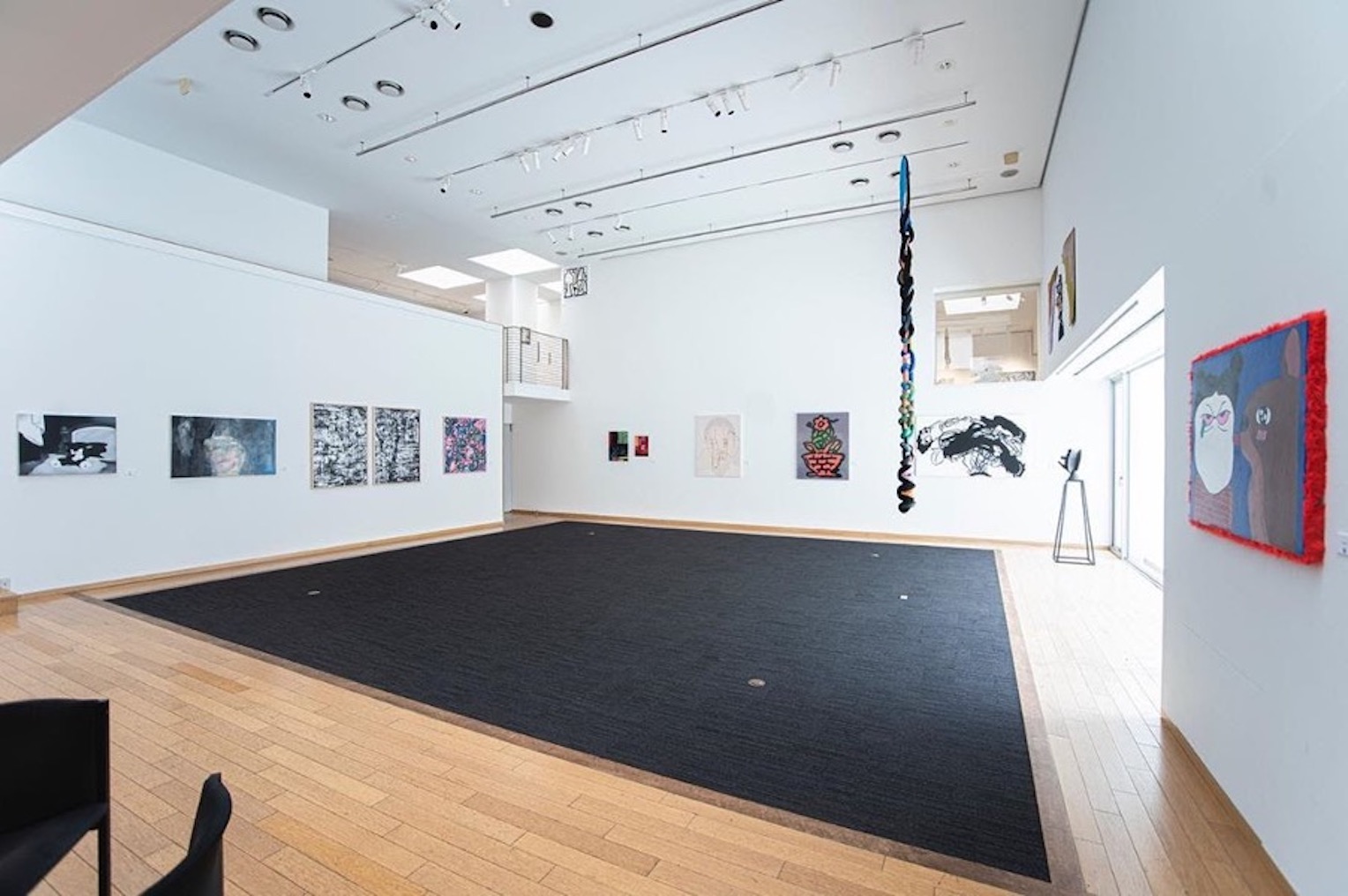
“ART START UP 100” involved selling 100 works of art submitted by artists for a uniform 100,000 yen each. All proceeds went to the artists, and the event also incorporated a mechanism to allow viewers to examine the art without attending the venue. (Image provided by: Art Technologies)
-So is BAF STUDIO – a place you opened this year – one of those spaces for analog communication?
Suematsu: Yes. It’s a place for direct communications between creators and art enthusiasts. While we do use digital tools, it’s important to actually see the real thing, as you might expect. We only exhibit art we truly love, and Mr. Hosono covers all the bases as a curator.
Hosono: Of course, it’s fun to create exhibits. You don’t just hang the artworks; you create exhibits while discussing them with the artist, to show everything in a variety of ways. More than whether or not it will sell, we focus on direction that shows the piece positively, before everything else.

Yukiko Yamasaki, Nana Soeda, and wimp will be featured in the first exhibit planned at BAF STUDIO – “NEWEN.” The exhibit also features waste from the art production process and the artists’ lives in order to make the process of consumption visible, from concept to completion. (Image provided by: Art Technologies)
-The Art Technologies office is located in Akasaka, isn’t it? What made you decide to locate BAF STUDIO in Bakuro-yokoyama?
Suematsu: It was close to warehouses, and also the biggest deciding factor was that the location is only a few minutes from Tokyo Station by taxi, since we get a lot of visitors from distant locations. Also, the rent is wildly different between here and Harajuku, in terms of gallery operations. That also impacts the artwork you handle and the prices you set.
-Does the city have any charms for you?
Hosono: I’m fond of the unique atmosphere, and the diversity. There aren’t a lot of city areas like this, even within Tokyo, are there? It has a long history, and it’s a wholesale district, with a lot of senior citizens managing it. On the other hand, it has “CITAN,” the hostel, and art galleries like “PARCEL.” It’s giving form to new space that resonates with us. It has clothing covered by warehouses, hostels bringing up the lodgings side of things, and it’s uniquely known for having lots of great restaurants, so the area might transform into an entirely new city if we can get culture covered. I can sense that sort of potential here.
How do you appeal to demographics other than your “passionate 5%”?
-What sort of person do you see most often among your visitors at BAF STUDIO?
Suematsu: We get a lot of hardcore art enthusiasts and artists, as well as business managers. We haven’t been open long, though, so we also get a lot of people we know.
Hosono: Our development of business in office coordination and corporate subscriptions is also creating opportunities for that demographic to drop by. Also, if we could get a middle demographic of epeople that didn’t fit in either of those categories to take an interest, I feel like things would change even further.
Suematsu: I think that at the absolute high end, no matter how hard you push it up, only about 5% of people (in the whole world) are interested in purchasing art. It’s always a crowded arena. But once you accept that, the question is how to appeal to the other 95%. We’re quite strongly aware of that question, which is part of why we started “ART TECHNOLOGIES ONLINE” and introduced AR.
-Could you give us more detail about your thoughts on efforts to make art appealing to the other 95% of people?
Suematsu: Like I touched on slightly at the start of the interview, we want to improve the standing of art in society through business. We want people to view art as something to consume, with the same attitude they’d have toward clothing, for example, instead of viewing it as something unrelated to them or out of reach for them.
But I’m sure that some of those 95% of people with no connection to art won’t have the confidence to say what they find good or bad. What I want to prioritize here is listening closely to customer responses to viewing artwork, and what they hope to gain by acquiring it. I’m not trying to sell things that everyone likes. Rather, I don’t mind if people don’t like these works at first, so long as they try displaying them. That’s the perspective I try to take when proposing a piece.
Hosono: That’s the way coordination works, after all.
Suematsu: For example, if someone was displaying art in an office, they might have a variety of goals… Improving the atmosphere or performance, or creating new opportunities to meet people, or improving the company’s status. I want customers to know it’s okay to select artwork from that perspective.
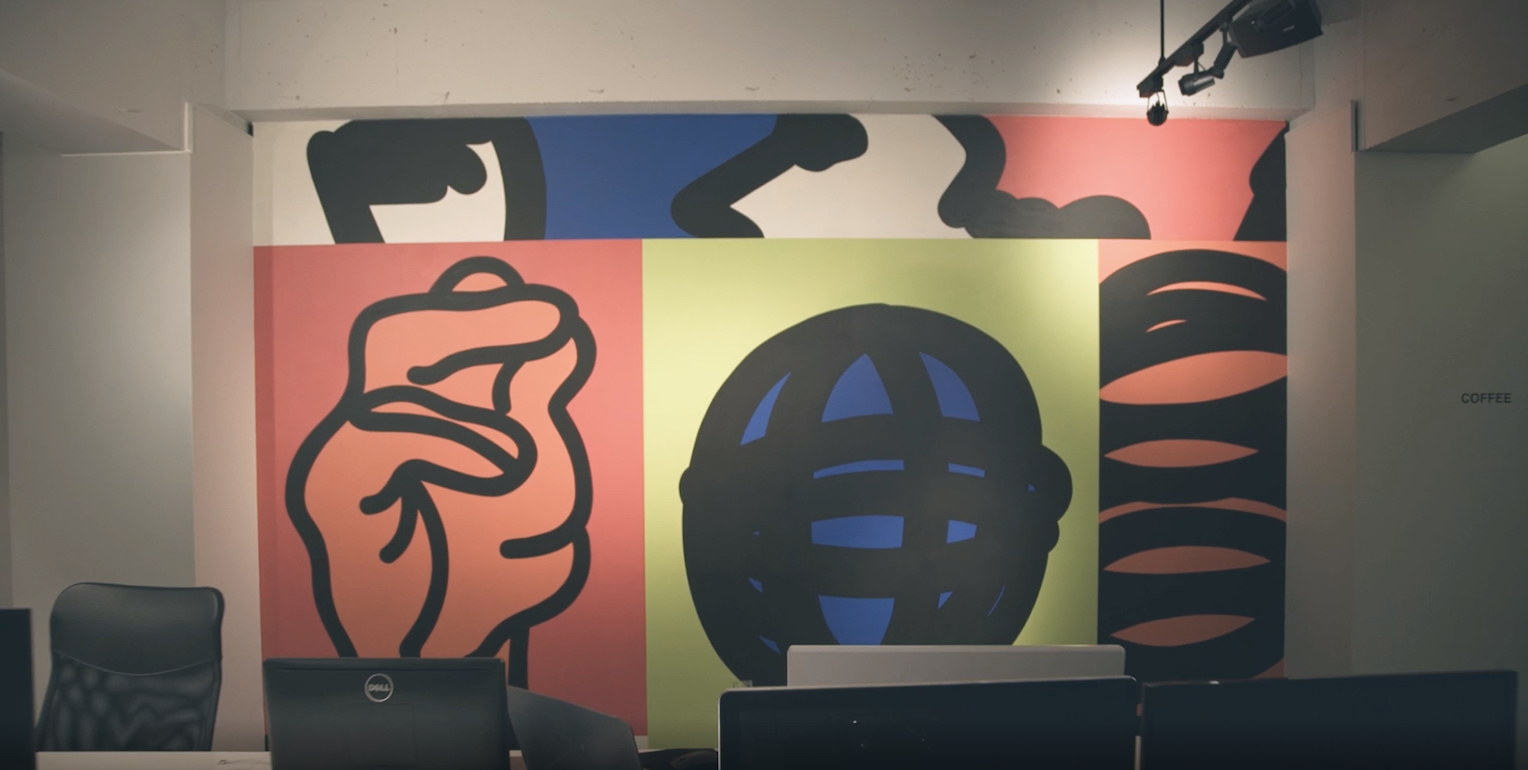
Art Technologies also offers mural services that transform office walls into works of art. (Image provided by: Art Technologies)
-How do customers react when you make proposals to them from that stance?
Suematsu: “I hadn’t thought that much about displaying art, but my employees loyed it when we tried it out, and we’ve gotten more job applicants.” People have said that in some cases.
-That would be a wonderful response. Doesn’t that also seem like a major discovery for that person, finding the power of art?
Suematsu: Wanting people to really experience that is part of why I want them to start by displaying something, rather than by searching for art they think people will like. They might get tired of it in three days, or they might suddenly discover its appeal five years later. You don’t know until you’ve spent time with a work of art.
Art is vital for the world, just as clothing, food, and shelter are.
-What sort of issues do you think the art industry faces, currently?
Suematsu: In the big picture, it’s that we don’t consider art to be a tool, in Japan. We have too negative a view of paying to consume art. Art isn’t so transcendent as all that. I think people need to let go of that assumption, first of all. It’s misunderstood unfairly in a lot of cases, but the existence of painting that cost as much as a house isn’t because of rich people playing with money. There’s a reason they were traded at that price, a history, and a future for the piece. If you don’t understand the significance of spending money on art, you’ll never draw out the true collectors.
-We tend to think of art and starving artists as a set, in Japan, so I feel like I really get what you’re saying, here.
Suematsu: I think you could say that culture and the economy first cross paths when you have economic activity and the foundation basic life necessities, and can wear nice clothes, eat good food, and listen to good music… When all of those value discoveries are in circulation. And what’s more, when that has happened, the ideal is for all elements to be equally important, rather than art falling below food or fashion in priority.
Hosono: After all, we can’t elevate art or our culture without creating an atmosphere that says “art stands alongside clothing, food, and shelter” as a necessity.
Suematsu: Since the coronavirus struck, all sorts of issues have come to the surface (in terms of compensation for the arts as a field). While it’s obviously incredibly wasteful, we absolutely need art. I think you’d be right to say it’s the final piece required for a dignified, human life, to maintain the world we know. That’s precisely why someone has to be there to support it. I think that’s equally true for painting and music and everything else.
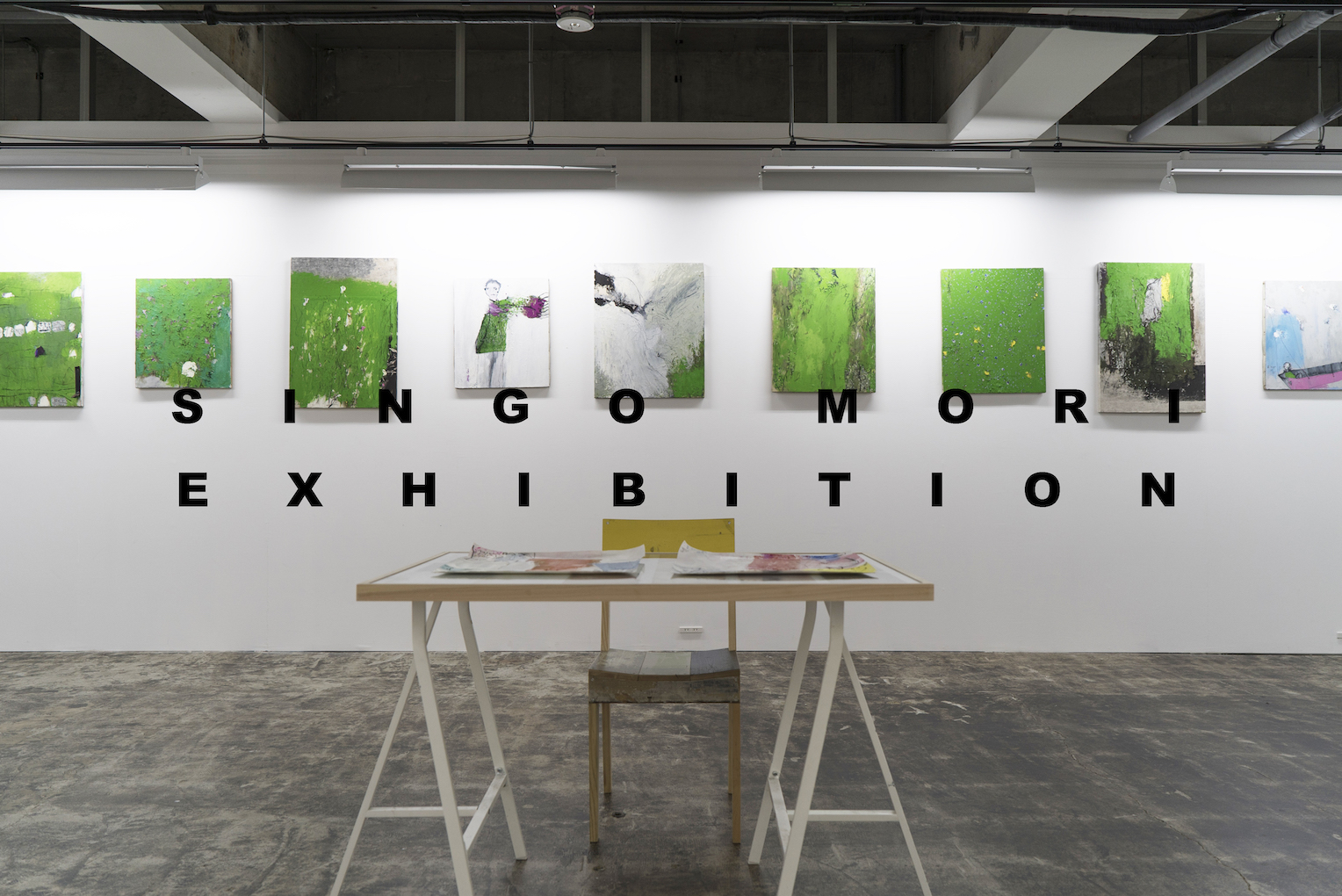
The work “82-Year-Old Beginner” by Shingo Mori was displayed in BAF STUDIO during this interview. (Image provided by: Art Technologies)
Continuing exhibits in the future.
-The role of art is under interrogation again, with the spread of the coronavirus. With that underway, what sort of efforts are you considering for the future?
Suematsu: We’ll be doing exhibits. Always, into the future.
Hosono: We deliberately never stopped, even when there was a state of emergency advisory out. Our only choice going forward is coexistence, so we wanted to do a trial, since we had a location.
Suematsu: The truth is that galleries serve two roles with exhibits: first, selling art, and also recording the prices each work of art sold for at the time. We are silently continuing with exhibits in order to put the things we do here to work for the company. Of course, things are changing little by little with online streaming and so forth, but the idea is that we’ll always be showing something if you come here.

-What sort of exhibits are you planning in the future?
Hosono: We’ll be holding the group exhibition “ATO” until June 28 (Sunday) in conjunction with the release of our “ART TECHNOLOGIES ONLINE” platform. I mentioned the platform earlier, and the exhibit features works by 25 artists all at once. Starting in July, we have an exhibit planned using works by Levi Pata, an artist with Native American heritage.
Suematsu: The June group exhibit seems like it will be another turning point for us. We’re hoping to get into a forward-thinking groove by showing so many pieces with timing like this.
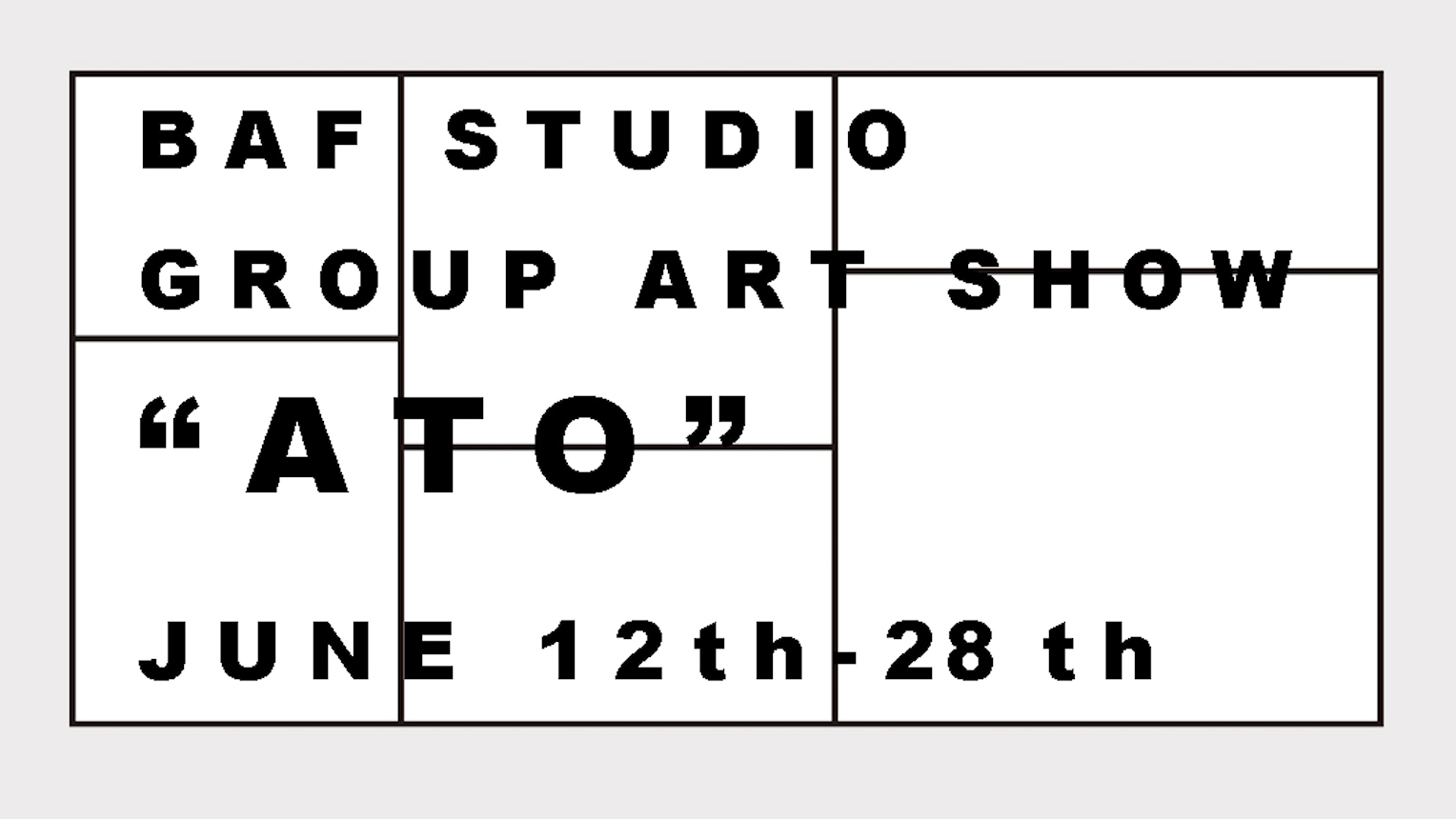
The BAF Studio group exhibit “ATO” will run from June 12 (Friday) through 28 (Sunday). The gallery is closed Sundays and Mondays. (Image provided by: Art Technologies)
Interview and text: Toshiya Oguma Photo:Daisuke Okamura
Art Technologies Co.Ltd.
Founded in January 2019 with aims of increasing points of connection between the economy and arts and culture, while also supporting artists in the production of work through a combination of art and technology. The company is involved in art subscription services, gallery management, and more, and is creating new services in order to make use of its remarkable artwork assets. Art Technologies also opened the gallery and studio “BAF STUDIO TOKYO” in the Bakurocho neighborhood of Tokyo in January 2020.




